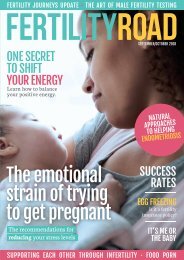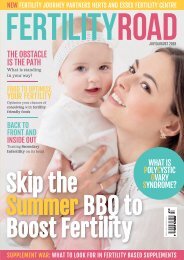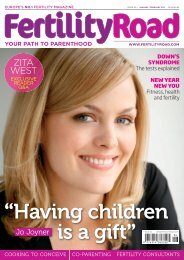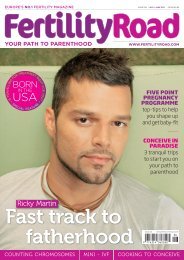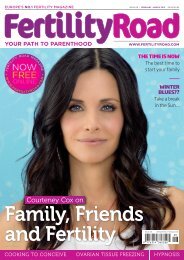Fertility Road Issue 14
Create successful ePaper yourself
Turn your PDF publications into a flip-book with our unique Google optimized e-Paper software.
Is there an example of where Eeva helped provide<br />
insight that you wouldn’t otherwise have had?<br />
It has been particularly useful to review the Eeva images<br />
on day 3, and compare the traditional methods of embryo<br />
assessment. On some occasions, an embryo may appear to have<br />
reached the right cell stage, - but reviewing the images has<br />
revealed that the embryo did not meet the cell division parameters<br />
at the correct time, and we have then not selected the embryo for<br />
transfer. We have continued to culture these embryos until day 5<br />
and have found a high correlation with failed blastocyst formation<br />
in these embryos.<br />
How can your patients learn more about Eeva<br />
if they are interested in this procedure?<br />
Wessex <strong>Fertility</strong> patients interested in Eeva can call us at 023<br />
8070 6000 to learn more. We also have a dedicated page on our<br />
website (www.wessexfertility.com/eeva). Additionally we have regular<br />
information seminars where we explain and discuss the use of Eeva.<br />
Our Consultants and Nurses also discuss the use of Eeva at Initial<br />
Patient Consultations and set up appointments.<br />
For more information about the technology behind Eeva, including<br />
the latest news and events please visit www.eevaivf.com..<br />
About Eeva<br />
The new Eeva test is clinically proven to help embryologists better<br />
select viable embryos at an early stage. The test was developed based<br />
on research conducted at Stanford University, which discovered that<br />
correlations in early cell division timings and the underlying health<br />
of the embryo can help determine the viability of the embryo.<br />
At the heart of Eeva is intelligent software that reliably and<br />
consistently assesses critical and subtle differences in early embryo<br />
development. This data helps IVF clinicians determine an embryo’s<br />
viability and select the embryos with the highest potential for transfer<br />
or freezing. Eeva is designed to safely identify which embryos are<br />
most likely to develop to blastocyst stage – a critical stage in embryo<br />
development that typically happens on Day 5 or 6. With access to this<br />
unique information, an IVF team can more accurately select the best<br />
embryo(s) for transfer which could improve pregnancy chances.<br />
In a clinical study of 755 embryos, embryologists using Eeva<br />
in combination with their traditional methods were able to<br />
significantly improve their ability to correctly identify non-viable<br />
embryos (85% of the time when using Eeva vs. only 60% of the time<br />
when using traditional methods).<br />
The Eeva Test is also available at CRM London, GCRM in<br />
Glasgow, Hewitt <strong>Fertility</strong> Centre in Liverpool, Sims IVF in Ireland<br />
and is coming soon to Bourn Hall in Cambridge.<br />
APRIL - MAY 2013 | WWW.FERTILITYROAD.COM |<br />
19



